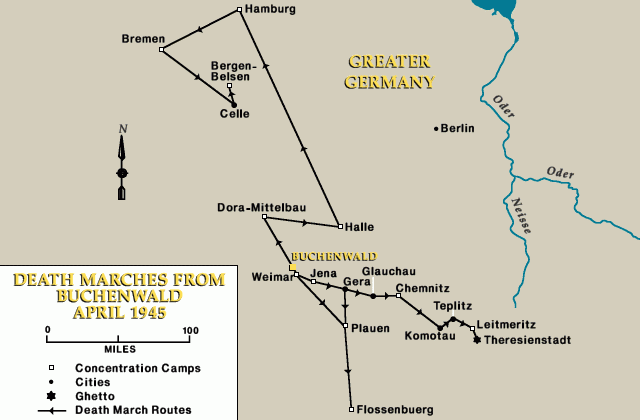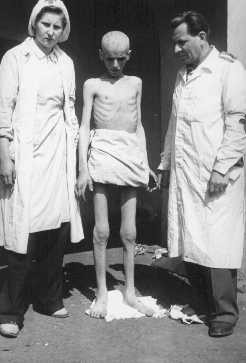
Theresienstadt: Final Weeks, Liberation, and Postwar Trials
The SS and police used the Slovak uprising as an opportunity to round up the last of the Slovak Jews. In late 1944, shortly after the collapse of the uprising, the SS and police moved 416 Slovak Jews out of the Sered transit camp to Theresienstadt, as Soviet troops had already cut off the rail and road lines to Auschwitz. Another 1,031 Slovak Jews arrived in early April 1945, after Sered was evacuated. On March 8, 1945, between 1,070 and 1,150 Hungarian Jews who had been deported to the Austrian border the previous autumn, arrived in Theresienstadt. 37 of the Slovak Jews and 35 of the Hungarian Jews had died by April 15, 1945.
In December 1944, the SS reconstituted the Council of Jewish Elders in Theresienstadt. Jacob Edelstein, the representative of the Protectorate Jews had been deported to Auschwitz with the transport of December 15, 1943; the SS shot him there on June 20, 1944. The SS shot Paul Eppstein, the representative of the German Jews, in Theresienstadt on September 27, 1944, on the eve of the last wave of deportations to Auschwitz. This left only Benjamin Murmelstein, the representative of the Austrian Jews to assume the leadership of the Council, with Leo Baeck as his deputy.
In 1945, hoping to use the surviving prisoners at Theresienstadt as a bargaining chip for opening negotiations with the western powers, SS chief Heinrich Himmler, Security Police Chief Ernst Kaltenbrunner, and other SS leaders agreed, as a token of good faith, to the release of 1,200 Theresienstadt prisoners in exchange for five million Swiss francs put up by Jewish organizations in an escrowed account in Switzerland. The 1,200 Jews (523 German Jews, 433 Dutch Jews, 153 Austrian Jews, and 91 Protectorate Jews) reached Switzerland on February 5, 1945. On the night of April 14-15, 1945, the SS permitted Swedish Red Cross personnel to take the surviving 423 Danish Jews out of Theresienstadt on trucks bound for Denmark.

Between April 20 and May 2, 1945, Theresienstadt lost its unique character with the flow of between 13,500 and 15,000 concentration camp prisoners into the camp-ghetto from other concentration camps (primarily Buchenwald and Gross-Rosen) and subcamps. Most, but not all were Jewish. More than 9,000 held Polish or Hungarian citizenship before World War II, increasing the total number of prisoners in Theresienstadt over the 42 months of its existence to more than 154,000. In May 1945, the total number of prisoners in the camp exceeded 30,000, of which nearly 17,000 had been there before April 20.

After again visiting the camp on April 6 and April 21, 1945, the International Red Cross took over its administration on May 2, 1945. SS Commandant Rahm and the rest of the SS fled on May 5 and 6. Scattered German military and SS units continued to fight Soviet forces in the vicinity of the camp-ghetto, which became part of the battlefront on May 8. Soviet troops entered the camp on May 9 and assumed responsibility for its prisoners the next day. By the end of August 1945, most of the former prisoners had left the camp, to be replaced by ethnic Germans arrested by the Czech and Soviet authorities.
After the war, Czech authorities prosecuted several members of the SS staff, including commandants Seidl and Rahm, who were convicted, sentenced to death, and executed in Litomerice. Commandant Burger escaped to West Germany, and, though condemned to death by Czech authorities in absentia, he settled in Essen, where he lived under a false name until his death in December 1991. Of the Czech Gendarmerie commanders, Theodor Janecek died in prison awaiting trial in 1946, while a Czech court in Litomerice found Miroslaus Hasenkopf guilty of treason and sentenced him to 15 years imprisonment. Hasenkopf died in prison in 1951.
Critical Thinking Questions
- What was the role of Theresienstadt in the Nazi strategy of deception? How was it different from the majority of concentration camps and ghettos?
- Did other camps have multiple purposes? If so, what were they?

